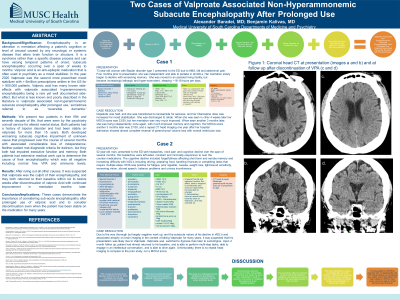Psychopharmacology and Toxicology
Session: Poster Session
(134) Two Cases of Valproate Associated Non-Hyperammonemic Subacute Encephalopathy After Prolonged Use

Trainee Involvement: Yes

Alexander W. Baradei, MD
Resident Physician
Medical University of South Carolina
Charleston, South Carolina, United States
Benjamin Kalivas, MD
Assistant Professor of Medicine and Psychiatry
Medical University of South Carolina
Charleston, South Carolina, United States
Presenting Author(s)
Co-Author(s)
Background/Significance
Encephalopathy is an alteration in mentation affecting a patient’s cognition or level of arousal caused by any neurologic or systemic disease that alters brain function or structure. It is a syndrome rather than a specific disease process and can have varying temporal patterns of onset; ‘subacute encephalopathy’ occurring over a span of weeks to months.
Valproic acid is an anti-epileptic medication that is often used in psychiatry as a mood stabilizer. In the year 2020 Valproate was the second most prescribed mood stabilizer with > 6million prescriptions written in the US for > 900,000 patients. Valproic acid has many known side-effects with valproate associated hyperammonemic encephalopathy being a rare yet well documented side-effect. But what is less known and poorly described in the literature is ‘valproate associated non-hyperammonemic subacute encephalopathy after prolonged use,’ sometimes referred to as ‘reversible dementia.
Methods:
We present two patients in their fifth and seventh decade of life, that were seen by the psychiatry consult service for altered mental status. Both patients had a history of bipolar disorder and had been stable on valproate for more than 15 years. Both developed worsening subacute cognitive impairment of unknown cause that progressed over the course of several months with associated considerable loss of independence. Neither patient met diagnostic criteria for delirium, but they both had impaired executive function and memory. Both patients had extensive medical work ups to determine the cause of their encephalopathy which was all negative including normal free VPA and ammonia levels.
Results
After ruling out all other causes, It was suspected that valproate was the culprit of their encephalopathy, and they both returned to their baseline within six to twelve weeks after discontinuation of valproic Acid.
Conclusion/Implications:
These cases demonstrate the importance of considering sub-acute encephalopathy after prolonged use of valproic acid and to consider discontinuation even when the patient has been stable on the medication for many years.
References:
Erkkinen, M. G., & Berkowitz, A. L. (2019). A clinical approach to diagnosing encephalopathy. The American Journal of Medicine, 132(10), 1142–1147. https://doi.org/10.1016/j.amjmed.2019.07.001 Pinson, R. (n.d.). Encephalopathy - mnhospitals.org. Retrieved April 4, 2023, from https://www.mnhospitals.org/Portals/0/Documents/patientsafety/Delirium/ACP%20Encephalopathy%20Coding%20Article.pdf Sean P. Kane, P. D. (n.d.). Valproate. Valproate - Drug Usage Statistics, ClinCalc DrugStats Database. Retrieved April 3, 2023, from https://clincalc.com/DrugStats/Drugs/Valproate Sztajnkrycer, M. D. (n.d.). Valproic Acid Poisoning. UpToDate. Retrieved April 3, 2023, from https://www.uptodate.com/contents/valproic-acid-poisoning?search=valproate+toxicity&source=search_result&selectedTitle=1~28&usage_type=default&display_rank=1 Tondelli, M., Vaudano, A. E., Sisodiya, S. M., & Meletti, S. (2020). Valproate use is associated with posterior cortical thinning and ventricular enlargement in epilepsy patients. Frontiers in Neurology, 11. https://doi.org/10.3389/fneur.2020.00622

